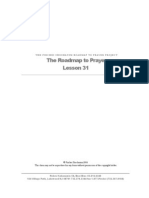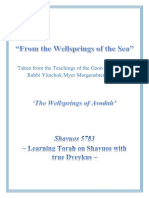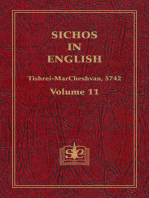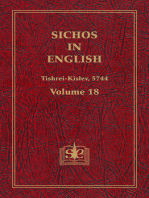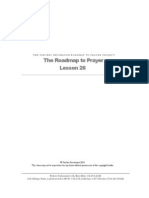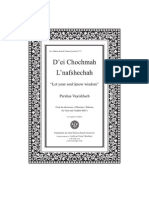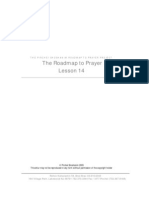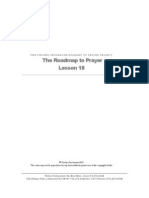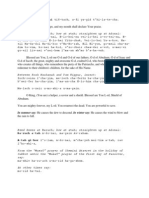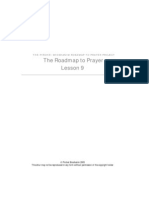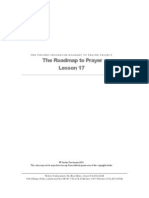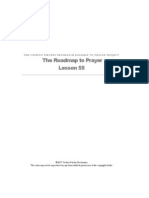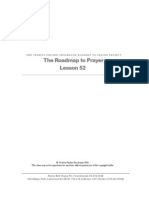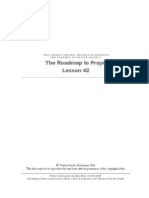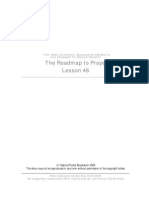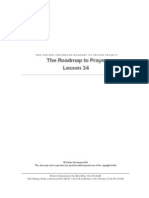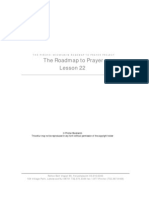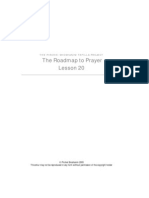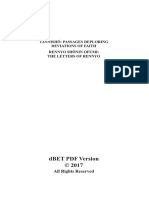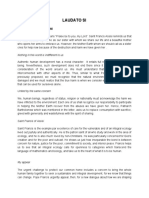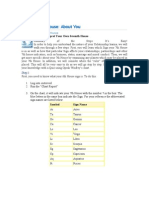Roadmap To Prayer Lesson 37
Roadmap To Prayer Lesson 37
Uploaded by
Krisztian KelemenCopyright:
Available Formats
Roadmap To Prayer Lesson 37
Roadmap To Prayer Lesson 37
Uploaded by
Krisztian KelemenOriginal Title
Copyright
Available Formats
Share this document
Did you find this document useful?
Is this content inappropriate?
Copyright:
Available Formats
Roadmap To Prayer Lesson 37
Roadmap To Prayer Lesson 37
Uploaded by
Krisztian KelemenCopyright:
Available Formats
Rehov Kahanami n 54, Bnei Brac 03.616.
6340
164 Vi l l age Pat h, Lakewood NJ 08701 732.370.3344 fax 1.877.Pi rchei (732.367.8168)
T H E PI RCH EI SH OSH AN I M ROADMAP T O PRAYER PROJECT
The Roadmap t o Prayer
Lesson 37
Pirchei Shoshanim 2006
This shiur may not be reproduced in any f orm without permission of the copyright holder
T
T
h
h
e
e
R
R
o
o
a
a
d
d
m
m
a
a
p
p
T
T
o
o
P
P
r
r
a
a
y
y
e
e
r
r
545
Maariv - Par t 3
The Fi rst Bl essi ng (bracha)
HaMaari v Aravim (Who bri ng on eveni ngs)
Asher Bidvar o Maar iv Ar avim (Who by His word He brings on the darkness of evenings).
The word A ravi m is in plural, indicating more than one kind of Evening. The
A budraham quotes I bn E zra that the there are two specif ic points of where there
occurs a change f rom daytime to nighttime. At f irst the sun disappears f rom sight
under the horizon. The second point occurs when the ball of the sun is well below
the horizon when the sky turns dark.
The benef it of this transition is obvious. Since the sun sets gradually, people are
f orewarned of the impending darkness and they will have time to take the necessary
measures to prepare themselves f or the darkness of the night. Were this to occur
suddenly, like someone shutting the light s in a room without windows, people would
be caught of f guard, and in the dark . Theref ore, we imply our recognition of this
benef it in this prayer and praise Him f or this.
BChochma Poseac h Sheari m UVisvuna Meshaneh It t i m
We express two specif ic languages ref erring to G-ds wisdom in Creation;
BChochma UVisvuna. These two expressions denote two specif ic meanings.
The verse in M i shl ei st at es: H ashem f ounded the earth with Chochma (wisdom),
established the heavens with T evuna (discernment/ sagacity).
(Rashi) Hashem founded the earth with wisdom - According t o t he Torah.
This is t he Tor ah, which is di scer nment and which is k nowl edge (i.e. wisdom).
We make ref erence to these aspect s of G-dly wisdom which were used in Creation of
the Heavens and the Earth when we take note of the opening of the gates and the
changing of time . As in many of our prayers, we allude to other things in the
subtleties of the language that is used. This however only f ocuses on the two
expressions, Chochma and T evuna, used; however, we must now explain the ref erence
to gates and changing times .
Lesson
37
T H E P I R C H E I S H O S H A N I M R O A D M A P T O P R A Y E R P R O J E C T
A N A T T A C H M E N T O F T H E S O U L L E S S O N 3 7
546
BChochma Poseach Sheari m
Chochma Poseach Shear im with wisdom He opens gates.
This ref ers to the gates of Heaven which is stated here in the plural as D ovid H amel ech
(K ing David) ref ers to them in T ehi lli m D alsei Shamayi m Psach (Open the doors of
Heaven). Y aak ov A vi nu also ref ers to the area above where the Bei s H ami k dash was to
stand, as Shaar H ashamayi m (the gate of Heaven)
1
. Perhaps when ref erring to the gates
of Heaven as being shut and needing to be opened we ref er to them in the plural as
we f ind such a ref erence when Shlomo H amelech was bringing the A ron Kodesh (The
Holy Ark) into the Kodesh Kodoshi m (the Holy of Holies) f or the very f irst time he
wasnt able to do it f irst because the doors of the inner sanctum stuck to each other
and sealed shut. I t wasnt until Shlomo H amelech beseeched H ashem to open the gates
f or the G-ds sake and f or the sake of his f ather D ovid H amelech (K ing David) that
gates f inally opened. Thus whenever we speak of gates opening, we ref er to them in
plural because their closure is by the two doors sealing shut.
UVi svuna Meshaneh It t i m
Visvuna Meshaneh Itt im - with discernment Hashem changes the times.
The changing of the times perhaps ref ers to the length of days and nights and
machli f es H azemanim ref ers to the changes in the seasons of the year.
Chochma USevuna
The Sefer Shi ras D ovi d suggests (based on Rav Chai m of V olozhi n) that Chochma refers
to the knowledge of science and nature while Sevuna ref ers to the esoteric
knowledge of the spiritual f orces that are behind nature. He bases this on the special
blessing one makes when one sees a brilliant non-Jewish scholar Baruch A sher nassan
mechochmasso lebassar vedam (Blessed is He Who has given f rom His knowledge to
mortals). From the wording of this blessing one sees that knowledge of science and
nature is called Chochma, as in the dictum Chochma bagoyi m taami n
2
(one who says
that non-Jews posses wisdom; believe him).
Sevuna (or T evuna) ref ers to the knowledge of hidden mystical realities of nature and
science. For example, one can study the science of the sun and track its path and its
pattern of warming etc. while one who posses Sevuna understands the spiritual
element that causes the sun to take its course and what its causes are in its warming
pattern etc. Of course, these spiritual secrets are known only to select pious
1
A budraham
2
Rosh H ashanah D af 20b
T H E P I R C H E I S H O S H A N I M R O A D M A P T O P R A Y E R P R O J E C T
A N A T T A C H M E N T O F T H E S O U L L E S S O N 3 7
547
T zaddi k i m and also in a limited amount; but it is they who are privy to such lofty
concepts and insights. These concepts are discussed in the scholarship of planning a
Jewish Lunar Calendar as discussed in the Gemara about Sod H aI bbur
3
(the Mystery of
calendrical intercalation) which is considered a knowledge that is recognized by non-
Jewish scholars as being especially well-known to the Jewish scholars. The Chasam
Sofer
4
comments that this knowledge is f ar too complex and dif ficult f or most people
to master. Very f ew have the intellectual acumen to become prof icient in the
scientif ic and mathematical studies required f or this undertaking. I t is written in the
Torah about this body of knowledge: Ki heechochmaschem uvi naschem leei nei haamim.
5
u n : _ n o , u 5 n_ : a u 5 n_ n 5 n n 5 u n o_ y_ , u n_ y n : y : : : o_ y n o , : 5 n - u p n_ n
n : n , u_ y p_ : : n - a : u 5 n , n r _ n :+ x _ n x _ n
6. And you shall keep [them] and do [them], f or that is your wisdom and your
understanding in the eyes of the nations, who will hear all these statutes and say,
Only this great nation is a wise and understanding people.
Rashi - And you shall keep [them] - This ref ers to study.
And do [them] - [To be interpreted] according to its apparent meaning; f or that is
your wisdom and your understanding [in the eyes of the peoples]. Through this you
will be considered wise and understanding in the eyes of the nations.
Regar ding the calculations of the New Moon and establishment of the Jewish Calendar;
f rom the History of the Jewish People - From Yavneh to Pumbedisa pages 190 -191
Mesor ah Publicat ions.
I n the year 359 CE (4119), Hillel I I and his court calculated all the f uture new moons
and consecrated in advance, all f uture months in accordance with these calculations.
Likewise, they calculated and consecrated all f uture leap years.
How accurate were the calculations used by Hillel I I in determining the calendar?
Of two things we are certain: 1) All measurements given by the Torah are as accurate
as necessary f or the purpose at hand. 2) That they stand on their own as the word of
H ashem and transmitted through the Sages. Nevertheless, it is interesting to compare
the data used by the Sages with the conclusion reached by modern technology.
3
Rosh Hashanah D af 20b
4
R MOSHE SOFER SCHREI BER - CHATAM SOFER - Born: Frankf urt, Germany, 1762. Died:
Pressburg, Hungary, 1839.Notes: Commentator and Halachist. A son-in-law of R Akiva Eiger, his f amily traced its
roots to Rashi. He was appointed Rav of Mattersdorf, Hungary, in 1798 and Rav and Rosh Yeshiva in Pressburg in
1807, he ultimately became one of the most influential poskim of his time. He became an outstanding leader of
Hungarian Jewry and led the struggle against Reform under the banner of Chadash assur min HaTorah/Torah Law
forbids innovations. Author of Torat Moshe, a commentary on the Chumash, Chatam Sofer, a commentary on the
Talmud, a commentary on the Shulchan Aruch, and Teshuvot Chatam Sofer, a large collection of Responsa.
Among his students is his son the Ktav Sofer.
5
D evarim 4:6
T H E P I R C H E I S H O S H A N I M R O A D M A P T O P R A Y E R P R O J E C T
A N A T T A C H M E N T O F T H E S O U L L E S S O N 3 7
548
I n Tractate Rosh Hashanah
6
the Talmud cites Rabban Gamliel: I have received a
tradition f rom the house of my f athers f ather that the moons month is not less than
29 days, plus 2/ 3 thirds of an hour plus 793 chalak i m (parts of 1080/ hour) f rom
one new moon to the next. This is equal to 29 days, 12 hours, 44 minutes, and 3
seconds (or 29.530594 days).
According to NASA (N ational Aeronautics and Space Agency) of the United States,
the length of the synodic month (i.e. the length of time f rom one new moon to the
next) is 29.530588 days. Thus, the dif ference this f igure and the one used by the
Sages is .000006 or six millionth of a day. This is the discrepancy for one month. I n
the 16 centuries f rom Hillel I I until now the discrepancy adds up to only 2.84 hours.
An amazing accuracy.
Umesadei r es Hakochavi m baraki a Ki ret zono
mesadeir es Hakochavim barakia Kir etzono (and He arranges the st ars in t he heavens in
accordance t o His will).
Despite our Sevuna-knowledge, ultimately all of creation is what G-d willed into
existence Ki retzono (in accordance to His will). Everything was created by G-d
Himself according to His inf inite wisdom which no human can understand to its f ull
extent . Even if we may observe some reason f or cert ain phenomena in creation, we
cannot f athom G-ds reasons f or creating any specif ic thing since H ashem had
multiple interconnected and interrelated reasons for creating anything in nature. For
example, the sun was created to give light, heat, promote growth, magnetic f ields etc.
etc. How and when and to what extent the sun will shine and aff ect its surroundings
etc. cannot be f ully grasped by human minds.
I n this blessing, the stars are used as the prime example of H ashem doing things
according to His inf inite wisdom and insight. There are billions of stars and
thousands of galaxies
7
in outer space. I n Sefer Tehi lli m (the Book of Psalms) D ovi d
H amelech (K ing David) speaks of H ashem taking each star and naming each of them
6
D af 25a
7
GALAXY, a massive ensemble of hundreds of millions of stars, all gravitationally interacting, and orbiting about a
common center. All the stars visible to the unaided eye from earth belong to the earths galaxy, the Milky Way. The
sun with its associated planets is just one star in this galaxy. Besides stars and planets, galaxies contain clusters of
stars; atomic hydrogen gas; molecular hydrogen; complex molecules composed of hydrogen, nitrogen, carbon, and
silicon, among others; and cosmic rays. Thousands of galaxies were identif ied and cataloged by the British
astronomers Sir William and Caroline Herschel and Sir John Herschel, during the early part of the 19th century.
Since 1900 galaxies have been discovered in large numbers by photographic searches. Galaxies at enormous
distances f rom earth appear so tiny on a photograph that they can hardly be distinguished f rom stars. The largest
known galaxy has about 13 times as many stars as the Milky Way.
T H E P I R C H E I S H O S H A N I M R O A D M A P T O P R A Y E R P R O J E C T
A N A T T A C H M E N T O F T H E S O U L L E S S O N 3 7
549
individually. A name represents a specif ic reason f or its creation just as we f ind that
the Torah describes the names of the Twelve Tribes at their birth and the reason for
their names. I n this blessing we speak of H ashem placing and arranging each and
every star in the sky in its unique and special place. The Z ohar learns a great and
exceedingly important lesson f rom this. Just as H ashem knows each individual star by
name and makes it His business (so to speak) to arrange each and everyone of them
in the sky so that all f it His plan and purpose; so too each individual Jew should
know that he is a signif icant being in the world that H ashem created and that G-d
doesnt f ind it to be beneath His dignity to be intimately involved in the physical and
spiritual progress of each individual just as He does with the stars.
Hashem Tzevakos
8
Shemo; Kei l Chai Vekayam Tami d Yi ml och Al ei nu
Leol am Vaed
Hashem Tzevakos
9
Shemo (Hashem; Master of Legi ons is His name), Keil Chai Vekayam
Tamid Yimloch Aleinu Leolam Vaed (The living G-d should reign over us forever)
According to A budraham, the above phrase should not be said at the closing of the
blessing of H aM aari v A ravi m since it has no connection with the theme of this
blessing that discusses daytime and night time and other related matters. Sephardi m in
f act omit this stanza f rom the blessing while A shk enazim recite it. The T ur brings that
his brother Rabbei nu Y echi el heard f rom his f ather the Rosh a reason to include this
stanza in their prayer. They explain its connection with the general theme of this
blessing is f rom the verse V ehayah leei s erev yi hyeh ohr
10
- u n n + n , u o_ n_ : y_ + n
: n : : : u ; " n y : n n a : y , n n : " (And it shall be one day that shall be
known to H ashem, neither day nor night; and it shall come to pass that at evening it
shall be light). This verse ref ers to the end of our exile amongst the nations when in
times of darkness and gloom, deep into Galus (Galut, exile) a light will appear. This
ref ers to our salvation f rom the clutches of our enemies. I n this allegorical ref erence,
the above verse links up with the blessing of H aM aari v A ravi m in the sense that we
are alluding to anot her kind of light (salvation) and darkness (exile). Theref ore, we
recite here a prayer f or the f uture that H ashem that H ashem should spread His li ght
8
The translation of this word is Master of Hosts/ Legions which is one of G-ds names. We do not pronounce it as
it is written Tzeva-os, rather it is said as Tzevak os, unless one recites it in a bracha (blessing). Rav Hirsch explains that
this attribute of G-ds Name represents His command over the almost inf inite amount of f orces that f orm the
universe.
9
The translation of this word is Master of Hosts/ Legions which is one of G-ds names. We do not pronounce it as
it is written Tzeva-os, rather it is said as Tzevak os, unless one recites it in a bracha (blessing). Rav Hirsch explains that
this attribute of G-ds Name represents His command over the almost inf inite amount of f orces that f orm the
universe.
10
Z echariah 14:7
T H E P I R C H E I S H O S H A N I M R O A D M A P T O P R A Y E R P R O J E C T
A N A T T A C H M E N T O F T H E S O U L L E S S O N 3 7
550
upon us and He should reign over us forever and cast darkness over our enemies.
Kei l Chai V ek ayam T ami d Y i mloch A lei nu L eolam V aed (The living G-d should reign
over us forever).
Hashem Tzevakos Shemo
Hashem Tzevakos Shemo (Hashem, Master of Legions is His Name)
This phrase is recited by Sephardi m even though the A budraham holds that it should
not be inserted into this prayer. Although Sephardi m do not say the latter portion
because they dont view it to be relevant with the theme of the blessing, this part they
say because its mentioned in a verse in A mos - Osseh shachar ei fah H ashem T zevak os
Shemo, n o y : _ n _ o n oy , np a x p:_ u o_ n y : n n a :_ y | :+ , n o - (He makes dawn
into darkness, and treads on the high places of the earth; the Master of Hosts is His
Name).
Rashi explains this as f ollows:
He makes dawn - f or the righteous like a bright light.
Darkness - He turns the brightness of the wicked into darkness (Y eshayah 8:22)
And behold, distress and darkness, darkness (y n) of oppression. Similarly, (I yov
10: 22) Land of darkness (n n o y) ; (ibid. 11:17) Darkness (n o y n) shall be like
morning. Your darkness shall shine like the morning.
Kei l Chai Vekayam Tami d Yi ml och Al ei nu Leol am Vaed
Keil Chai Vekayam Tamid Yimloch Aleinu Leolam Vaed (May the living and enduring G-d
continuously reign over us for all eternity).
There is a question amongst the commentaries
11
where to place the word T ami d
(continuously). Should it be read together with the latter part of the phrase as in the
above translation? Or does the word T ami d describe G-d, Who endures T ami d
(f orever)? Then Y imloch A lei nu L eolam V aed refers to H ashem W ho we beseech that H e rei gn
over us forever.
Please see f inal blessing of Baruch H ashem L eolam f or a f urther discussion of this
topic.
The Second Bl essi ng (bracha)
Ahavas Ol am
I n the morning, the second blessing which we recite bef ore the Reading of Shema
begins with A havas Olam (an eternal love) according to some and with A havah Rabba
11
Pri sha 236:3
T H E P I R C H E I S H O S H A N I M R O A D M A P T O P R A Y E R P R O J E C T
A N A T T A C H M E N T O F T H E S O U L L E S S O N 3 7
551
(a great love) according to others. All agree that by T efi llas A rvi s (Arvit, nighttime
prayers) the blessing begins with the words A havas Olam (an eternal love)
12
. The
reason we use this expression at night is
13
because although nighttime corresponds to
exile and troubles, we recognize that this is only a temporary state and that H ashem
loves us eternally and will eventually f ulf ill the prophecies and bring us back to the
Land of I srael and rest His Divine Presence amongst us once again at the holy site of
the Bei s H ami k dash (Holy Temple). This exact terminology V eA havas Olam A havti ch (I
loved you with eternal love) is expressed by the N avi Y i rmiyahu (Prophet Jeremiah)
14
.
Beshachvei nu Uvek umei nu Nasi ach Bechukecha
Beshachveinu Uvekumeinu Nasiach Bechukecha (When we r etire and when we ar ise we
will discuss Your statut es).
We will constantly be involved in Torah study, even our small talk
15
will be about
Torah as we consider Torah more than just a subject to study but as part of the f iber
of our lives, as we go on to say in this blessing Ki hei m chayei nu veorech yamei nu (f or they
are our li fe and the l ength of our days). The Ohr H aChaim
16
explains that li fe ref ers to our
existence in this world (Olam H azeh) which means that our existence is only to serve
our Creator through Torah and M i tzvos. The l ength of our days means eternal lif e in the
World to Come (Olam H aba) which through living a li fe devoted and dedicated to
Torah and M i tzvos we are guaranteed eternal blessing and joy in the World to Come
(Olam H aba).
Another reason we make the above point in this blessing according to L i k utei
M ahari ch
17
is to show our devotion to H ashem and to His Torah. He brings f rom the
Gemara in M enachos
18
that technically one can f ulf ill ones obligation of Torah study in
12
There are other slight dif f erences between Sephardim and A shk enazim in this blessing.
13
Based on the explanation of the Gra (H aggadah shel Pesach - Passover Haggadah, V ehi Sheamda) that at night
H ashems love f or us is not visibly strong and it is because of the past love that He had f or us that He doesnt ever
abandon us. I n the Morning we recite (according to some customs) A havah Rabba which represents His great love
for us which is alluded to because the Morning corresponds to Redemption.
14
Y irmiyahu Chapter 31:2
15
The word N asi ach (talk or chat) has this connotation (Si ach Y itzchok )
16
R CHAI M I BN ATTAR - OHR H ACHAI M - Born: Sale, Morocco, 1696.Died: Jerusalem, Israel, 1743 Notes: Torah
commentator, Kabbalist, Talmudist, he is known as having lived a particularly saintly life. He was the Rav of Sale until he
moved to Jerusalem in 1740, where he established an important yeshiva. Author of the Ohr HaChaim, a commentary on the
Torah where he uses the four methods of Pardes, and of Pri To' ar on Yoreh Deah
17
By Rabbi Yisrael Friedman ztl (published in the year 1900)
18
D af 110
T H E P I R C H E I S H O S H A N I M R O A D M A P T O P R A Y E R P R O J E C T
A N A T T A C H M E N T O F T H E S O U L L E S S O N 3 7
552
the morning and evening through the Reading of Shema
19
. Therefore, we express
ourselves here in the blessing that precedes the Shema that just as H ashem has
unconditional love for us, we also love Him in return and its because of our love f or
Him that we cling to His Torah and constantly converse in it day and night. We are
not just satisf ying a requirement to study Torah twice a day, as much as we are
li vi ng it. Ki Heim Chayeinu (for they are our life)
A T T H I S PO I N T , K R I A S S H E M A I S RE C I T E D A N D T H E
B L E SSI N G T H A T F O L L O W S I T B E G I N S W I T H
V E E M U N A H K O L Z O S E ( A N D F A I T H F U L I S A L L T H I S)
20
.
The Thi rd Bl essi ng (bracha)
VeEmunah Kol Zose
VeEmunah Kol Zose (and faithful is all this)
I f one looks in the Si ddur (Prayer Book) one will see that in truth, the blessing af ter
Kri as Shema has another word bef ore we say V eE munah Kol Z ose. That word is E mmes
(it is true). So really we are stating that Kol Z ose - all this (ref erring to all declarations of
Kri as Shema) is E mmes V eE munah (true and f aithf ul). The only reason we do not
actually read it like this is because we are enjoined to put the word E mmes together
with the closing statement of Kri as Shema and say H ashem E lok ei chem E mmes as per the
verse V aH ashem E lok i m E mmes :_ u o_ n_ p n n_ u , n - :_ p u :y | : n u _ n u (But
H ashem E lok i m (G-d) is true; He is a living E lok i m (G-d) and the K ing of the world).
The A budraham explains that the two expressions of E mmes V eE munah represent
Torah and M i tzvos.
Emmes represents Torah which is Truth as expressed by D ovi d H amelech
(K ing David) in T ehi lli m
21
- V esorascha Emmes (and Your Torah is true).
Likewise, Shlomo H amelech (K ing Solomon) in M i shlei
22
writes in ref erence to
Torah knowledge Emmes k enei veal ti mk or (Purchase truth; do not sell it).
Emunah ref ers to M i tzvos as stated in the verse in Tehi lli m - Kol mitzvosecha
Emunah
23
(all Your statutes are faithful). Alternatively, we ref er to H ashem
19
The Gemara goes on to say that one should not reveal this to the unlearned so that they should not suf f ice with
this minimal amount
20
This ref ers to all declarations of Krias Shema (E itz Y osef)
21
119:142
22
23:23
23
119:86
T H E P I R C H E I S H O S H A N I M R O A D M A P T O P R A Y E R P R O J E C T
A N A T T A C H M E N T O F T H E S O U L L E S S O N 3 7
553
as the true and faithful One f or He is always being deposited at nighttime
with weary and tired souls and every morning He returns truthf ully and
f aithf ully; He even returns them invigorated and rejuvenated
24
. This is
expressed in T ehi lli m
25
, Padi sa osee H ashem Kei l emmes, | + a , n: + p o , n + o
n " n n_ : p u o_ n " (I n Your hand I entrust my spirit; You have redeemed me,
O Hashem of truth).
The A budraham writes that we always f ollow Kri as Shema with praise to H ashem f or
redeeming us out of the bondage of M i tzrayi m (Egypt). Since the last paragraph of
Kri as Shema is about H ashem taking us out of M i tzrayi m (Egypt), the bracha that
f ollows it is also about the same theme. I n the morning we say E mmes V eY atziv (I t is
true and it is f irm) in commemoration of the miracles that H ashem performed f or us
when taking us out of M i tzrayi m (Egypt). At night we say E mmes V eE munah to
express our f aith that H ashem will redeem us f rom our present Galus (Galut, exile).
Additionally, it commemorates the f aith we had on the night of M ak k as Bechoros
(smiting of the f irst-born), when H ashem killed the f irst-born of M i tzrayi m (Egypt) and
spared the f irst-born of the Jews. On that night we put our trust in Him that He was
going to redeem us the next morning, which is E mmes VeEmunah which is true
and faithful. He also kept His promise and took us out of M i tzrayi m (Egypt) the next
morning which is E mmes VeYatziv that is trueand firm.
Haosseh Gedol os ad ei n chei ker Ni ssi m Veni fl aos ad ei n mi spar
Haosseh Gedolos ad ein cheiker (Who performs great deeds beyond our comprehensi on)
Nissim Veniflaos
26
ad ein mispar (mi racles and wonders beyond number).
The M albi m
27
explains the f irst verse; H aosseh Gedolos is ref erring to the marvels of
creation that are so vast, that they are beyond our comprehension what their purpose
is in creation. Even if an entire galaxy would vanish, its loss wouldnt be noticed in
the vastness of space. Accordingly, the next verse; N i ssi m V eni flaos ref ers to general
miracles of nature that occur all the time.
24
M edrash Tehilli m 25:2
25
31:6
26
According to certain texts the word N issim is omitted
27
I yov 9:10 R Meir Leib Ben Yechiel Michael Malbim Born: Voloshisk, Poland, c. 1809. Died: Kiev, Russia, 1879. Notes:
Commentator and gifted public speaker. He was appointed Rav of Wrteschen in 1839 and Rav of Bucharest and Chief Rabbi
of Romania after 1858. A leading opponent of reform, he was imprisoned due to false accusations by the reformers. He was
sentenced to death and only through the efforts of Sir Moses Montefiori did the Romanian government change his sentence to
exile. Author of Malbim on Chumash, where he focuses on the connection between the Oral Law and the Written Law, and a
commentary on the whole Tanach, which gained widespread acceptance. Author of Artzot HaChaim, a commentary on the
Shulchan Aruch.
T H E P I R C H E I S H O S H A N I M R O A D M A P T O P R A Y E R P R O J E C T
A N A T T A C H M E N T O F T H E S O U L L E S S O N 3 7
554
Gedol os
I n keeping with the theme of Y etzi as M i tzrayi m (exodus f rom Egypt), the Si ddur
M aggi d T zedek explains the f irst verse is ref erring specif ically to the great miracles that
G-d perf ormed at the Red Sea. As we ment ion on the night of Passover in the
Haggadah, the miracles perf ormed at the splitting of the Red Sea were f ive-f old the
miracles perf ormed in Egypt. This is alluded here by the word Gedolos(great deeds)
which is the language used by the Torah to describe the miracles at the Red Sea,
V ayaar Y israel es hayad H agedolah etc.
28
n : : o :_ _ - + _ n n :+ x _ n , u _ : x n a u o_ n n o y : o_
(And I srael saw the great hand, which H ashem had used upon the Egypt ians).
Ni ssi m Veni fl aos
The next verse, N i ssi m V eni flaos
29
ad ei n mi spar ref ers to a wondrous hidden miracle
performed f or the Jews when traveling through the desert on their way to the Land
of I srael. This occurred at the Valley of Arnon when the enemies f rom the Amorite
nation lay in ambush on the two sides of this valley hiding in the clef ts and crevices
of two mountains on either side ready to attack the Jews on their way through the
narrow valley below. H ashem performed an incredible miracle bringing the two
mountains together crushing the Amorite soldiers hidden inside. The Jews passed by
without incident and without even noticing the great miracle that H ashem perf ormed
f or them. H ashem then miraculously separated the mountains again and sent the
W ellspri ng of M i ri am (Beei ra shel M i ryam) through the mountains to sweep down the
remains of the enemy soldiers so that the Jews could see the great miracle that
H ashem perf ormed f or them. The pasuk (verse) instructs us to speak about this great
miracle as we also speak of the miracles that happened in Egypt. 5`: _ y _n c a : : o
n_ n : n n n n `n n oc a a : n : _ n`n n : : u . The pasuk (verse) reads A l k ei n
yeiamar besefer mi lchamos H ashem (Theref ore it is said in the book of the Wars of
H ashem) E s vahei v basufah vees hanechali m A rnon
30
(The gif t of the Reeds - i.e. the Red
Sea - and the rivers of Arnon - i.e. the f lowing blood and body parts which signaled
to the Jews the miracle that was perf ormed). As Rashi explains, the beginning of the
verse implores us to speak of the great miracles that G-d performed for us; the
splitting of the Red Sea and the Ri vers of A rnon.
Hamadri chei nu al Bamos Oyvei nu; Vayarem Kar nei nu al kol Sonei nu
Hamadricheinu al bamos Oyveinu (Who makes us tread on the heights of our enemies)
Hamadr icheinu al bamos Oyveinu (Who makes us tread on the heights of our enemies)
28
Shemos 14:31
29
According to certain texts the word Nissim is omitted
30
Bamidbar 21:14
T H E P I R C H E I S H O S H A N I M R O A D M A P T O P R A Y E R P R O J E C T
A N A T T A C H M E N T O F T H E S O U L L E S S O N 3 7
555
We had mentioned previously in this blessing that H ashem punished the Egyptians
measure f or measure - M i dah Knegged M i dah. Just as they drowned our babies in the
water, they were drowned in the waters of the Y am Suf - the Red Sea. Here we
mention something else, that H ashem makes us tread on the heights of our enemies
and raised our pride above all who hate us (H amadri chei nu al bamos Oyveinu vayorem
k arnei nu al k ol Soneinu). These ref erences ref er to two things. H amadri chei nu al bamos
Oyvei nu (Who makes us tread on the heights of our enemies) ref ers to A malek who is
our arch enemy. The Gemara M egi llah
31
states when M ordechai was being royally
paraded around the city of Shushan by H aman the descendant of A malek , M ordechai
said to H aman the verse V eatta al bomaseimo sidroch (but you will trample the
haughty ones). The next verse vayorem k arnei nu al k ol Sonei nu (and raised our pride
above all who hate us) ref ers to the wars of Yehoshua against the 31 K ings that lived in
the Land of I srael at that time.
Haosseh l anu Ni ssi m UNekama be Pharaoh Ossos UMofsi m beadmas
Bnei Cham
Haosseh lanu Nissim UNekama bePhar oh (Who wrought for us miracles and vengeance
upon Pharaoh)
Ossos UMofsim beadmas Bnei Cham (signs and wonders upon the offspring of Cham
32
)
The M aharal of Prague explains the dif f erence between an Os (sign) and a M ofess
(wonder). Os ref ers to a miracle within the rules of nature such as the plague of
Ki nni m (lice) which came about by A haron striking the Egyptian soil with a stick. This
is expressed in the Passover Haggadah - beossos zeh hamateh (and with signs, this is
the stick) - ref ers to A haron striking the ground with his stick
33
. U bemofsim zeh hadam
(and with wonders, this is the blood) - refers to the plague of blood where all the
waters of Egypt turned miraculously to blood, which is a miracle beyond the rules of
nature. This is what we ref er to here with OssosUMofsim beadmas Bnei Cham
34
.
Alternatively, it ref ers to the simultaneous punishment and destruction that occurred
in the Land of Cham i.e. Egypt when the armies were drowning in the Red Sea as
31
D af 16a
32
M itzrayim, the f orerunner of the Egyptian nation was a son of Cham who was N oachs son (Bereishis 10:6)
33
Shemos 8:12
34
Siddur M aggid Tzedek
T H E P I R C H E I S H O S H A N I M R O A D M A P T O P R A Y E R P R O J E C T
A N A T T A C H M E N T O F T H E S O U L L E S S O N 3 7
556
mentioned in Rashi on the verse in A z Y ashir - I shall flee before I srael for H ashem i s wagi ng
war for them i n E gypt
35
.
Siach Y itzchok explains H aosseh l anu N issi m U N ek ama bePharoh (Who wrought for us
miracles and vengeance upon Pharaoh) in the f ollowing manner. He says that there
were three reasons for the miracles in M i tzrayi m (Egypt). 1) For the honor of Bnei
Y i srael. 2) To punish Pharaoh. 3) To teach people that H ashem is the One and Only
G-d. Accordingly, he explains this prayer in three parts. 1) H aosseh lanu N i ssi m -
H ashem perf orms miracles f or us; this is to honor the Bnei Y i srael . 2) N ek ama
bePharaoh He directs His vengeance against Pharaoh to punish him for his wicked
deeds. 3) Ossos U M ofsi m beadmas Bnei Cham, H ashem brings signs and wondrous acts
in the land of Bnei Cham (Egypt) in order to teach them that H ashem is the One and
Only G-d Who created the world and Who continues to control its destiny and He is
able to change nature at will to protect those who serve Him f aithf ully.
Vayot zei es Ammo Yi srael leChei rus Ol am
Vayotzei es Ammo Yisr ael leCheir us Olam (And he took His nation Yisr ael out f or eternal
fr eedom).
The Maharal of Prague in the Sefer Gevuros H ashem
36
writes that people question the
signif icance of the Exodus f rom Egypt since the Jews are not better of f now as they
are still in Galus (Galut, exile). He writes that the question is totally incorrect. When
H ashem took us out of M i tzrayi m, it created a state of f reedom that became part of our
f iber and essence. Once f reed by H ashem, we became a nation beholden to Him and
totally subjugated to performing His will. Any kind of subsequent bondage that may
trap us is only a transitory state; not our essence or destiny. This is true f reedom; this
is eternal f reedom - Chei rus Olam.
Hamavi r Banav bei gi zrei Yam Suf
H amavi r Banav bei n gi zrei Y am Suf (Who passes His children though the sections of the
Sea of Reeds). At this point we turn our attention to the miracles H ashem did f or us at
the splitting of the Red Sea in detail. We praise Him f or cutti ng the sea into twelve
portions making paths f or each tribe to travel through individually. The M edrash
speaks of how there was f resh clear water f or the Bnei Y i srael to drink f lowing f rom
these walls, as well as delicious f ruits.
35
Shemos 14:25
36
Chapter 61
T H E P I R C H E I S H O S H A N I M R O A D M A P T O P R A Y E R P R O J E C T
A N A T T A C H M E N T O F T H E S O U L L E S S O N 3 7
557
Veraoo Banav Gevurasso Shi bchu Vehodu Li shmo
V eraoo Banav Gevurasso Shi bchu V ehodu L i shmo (And His children saw His strength;
they gave praise and thanks to His name).
Af ter splitting the sea f or the Bnei Y i srael to pass through safely out of harms way,
H ashem performed another miracle f or the Jews to witness with their own eyes. They
saw how H ashem drowned the Egyptians who were in hot pursuit of them and when
seeing this they sang H ashems praise in song. The Shirah of A z Y ashi r is what our
Sages consider the f irst time in history that people sang H ashems praise in song. This
song is considered to be so exceptional that we recite it daily in the morning Pesuk ei
D eZ i mra prayers. I ts so unique that anyone who says it with great joy is promised
that his sins will be forgiven
37
. The Bei s H alevy explains although A dam sang a song of
praise a long time bef ore this, which is recorded by D ovi d H amelech (K ing David) in
T ehi lli m in the chapter that we recite every Shabbos - M i zmor shi r leyome haShabbos (A
psalm, a song f or the Sabbath day), there is something unique about the song of A z
Y ashi r. What is unique is that this was the f irst time that the hand of H ashem brought
salvation and punishment simultaneously. He brought salvation for the Jews and
destruction f or the Egyptians all in the same event. This level of Divine Prot ection
was experienced and expressed for the f irst time in history by the Jewish nation, by
Kri as Y am Suf (the splitting of the Red Sea) and A z Y ashi r. The excitement of this
momentous event elicited great praise and thanks - Shibchu VeHodu L i shmo. The
two expressions represent the dual meaning of the miracle of Kri as Y am Suf (the
splitting of the Red Sea).
UMal chusso Berat zone Ki bl u Al ei hem, Moshe Uvnei Yi sr ael Lecha Anu
Shi r a Besi mcha Rabba; Veamru Chul am
M alchusso Beratzone Ki blu A lei hem, M oshe U vnei Y i srael BeSimcha Rabba -
Veamru Chulam (and His kingship they accepted upon themselves gladly, M oshe
and the Bnei Y i srael raised their voices to You in song with great joy - and they all
said)
I n the Sefer (book) Baruch Sheomar the author stresses to avoid the common mistake
that Chazzani m make, putting together the words BeSi mcha Rabba (with great joy) with
V eamru Chulam (they all said together). Rather, the correct way to recite it would be
to keep the words BeSi mcha Rabba together with the above words about the song of
praise (Shi rah) which the Bnei Y i srael sang with abundant joy. Then V eamru Chulam
ref ers on the next verse that comes right af ter this which states that they all said M i
Chamocha (Who is like You)
37
M ishna Berura 51:17 quoting the Z ohar
T H E P I R C H E I S H O S H A N I M R O A D M A P T O P R A Y E R P R O J E C T
A N A T T A C H M E N T O F T H E S O U L L E S S O N 3 7
558
Veneemar Ki Phadah Hashem es Yaakov
V eneemar Ki Phadah H ashem es Y aak ov (and it is f urther stated: H ashem has redeemed
Jacob). The A budraham notes that in the morning we say this in the f uture tense while
in the evening it is said in the past tense. He explains this to mean that in the morning
we say a prayer that H ashem should save us f rom our enemies who try to harm us
daily in our exile in f oreign lands, while in the evening we say it in past tense giving
thanks to H ashem for protecting us during this day.
The Fourt h Bl essi ng (bracha)
Hashki vei nu
H ashk i vei nu H ashem E lok ei nu L eShalom (Lay us down to sleep, H ashem our G-d in
peace). I n the bracha (blessing) of H ashk i vei nu we ask H ashem to allow us to have a
peacef ul night of sleep so that we can f eel ref reshed the next morning ready to serve
H ashem with all our strength and f ervor
38
.
The blessing of H ashk i vei nu was added af ter Goal Y israel (Who redeemed I srael) as a
prayer for Divine Protection at night when it is most common f or there to be danger
lurking. I n truth, we are meant to be Somech Geulah leTefi lla (put together Geulah and
T efi lla) as we do by Shachari s without int erruption. The Gemara in Berachos
39
explains
that this is not an interruption because it is considered to be a Geulah A ri chta (an
extended Redemption).
A budraham brings f rom the Raavad who asks that it is still dif f icult to understand why
we only recited an ex tended Geulah by M aari v and not by Shachari s? He answers that
when we were redeemed f rom our bondage in Egypt we were redeemed at midnight
on the 15
th
of the Hebrew month of N i ssan. That is when H ashem killed all the f irst-
born Egyptians and Pharaoh sent orders to chase us out of Egypt. However, G-d
only commanded us to leave the next morning. Theref ore, since the redemption at
night was extended until morning, we add a blessing making it a Geulah A ri chta (an
extended Redemption).
Vesaknei nu Beei t zah Tovah
V esak nei nu Beei tzah T ovah (and set us aright with good counsel). A budraham explains
that nighttime is usually when one tends to ref lect on the day that has passed and
plans ahead f or the next day. We theref ore beseech H ashem to help us in this process
and guide our plans in the right direction.
38
Rav H irsch ztl
39
D af 4b
T H E P I R C H E I S H O S H A N I M R O A D M A P T O P R A Y E R P R O J E C T
A N A T T A C H M E N T O F T H E S O U L L E S S O N 3 7
559
At the end of this bracha (blessing) each individual answers A men at the conclusion of
the bracha Shomer A mmo Y i srael L oad, according to the Mechaber as practiced by
Sephardi m. This is because the blessing of H ashk i vei nu concludes the series of blessings
- the Bi rchos Kri as Shema. Even according to the other custom of not answering A men
to ones own bracha, if one concludes this blessing at the same time the Chazzan
concludes it, one should answer A men.
The Addi t i onal Bl essi ng: Baruch Hashem Leol am
The f inal blessing of Baruch H ashem L eolam is recited only according to some customs
as mentioned in the previous lesson
40
. According to those who recite it, it was
originally meant to be in place of the 18 blessings of Shemoneh E srei . I t is a collection
of various Script ural verses. L i k utei M aharich brings that there is a question whether
the verse H oshi ei nu Hashem E lok ei nu (Save us H ashem our G-d) is said f rom Tehi lli m
106:47 or if a similar verse H oshi ei nu E l ok ei Y ishei nu (Save us O G-d of our salvation)
is recited f rom I D i vrei H ayami m 16:36
41
. According, to the f ormer, this verse would
bring the total of times the name of H ashem is mentioned in this prayer, to 19. This
f ollows the present-day f ormat of Shemoneh E srei which now consists of nineteen
blessings ever since the blessing V elamalshi ni m(as for slanderes)
42
was inserted
in Talmudic times; so too the Geoni m that composed this blessing have in it 19 times
the name of H ashem. However, L i k utei M aharich pref ers the verse f rom D i vrei
H ayami m without the additional mention of H ashems Name in it, since when the
Gemara states that the 18 brochos of Shemoneh E srei correspond to the 18 times H ashems
Name is mentioned in the psalm M i zmor L eD avid or the 18 times it is mentioned
in Kri as Shema, the 19
th
bracha is not alluded to by another ention of H ashems Name.
Rather, it is alluded to in the verse Kei l H ak avode H i ri m
43
(the G-d of Glory thunders),
in the f ormer, and in the word E chad (the Only One) in the latter. Theref ore, if the
Geoni m allude to the 18 blessings of Shemoneh E srei in the 18 names of H ashem, it is
not possible to say that there is a 19
th
mention of G-ds name f or this purpose.
Theref ore, it would be better according to L i k utei M ahari ch to recite the blessing f rom
D ivrei H ayami m instead. Notwithstanding, the prevalent custom is to recite the verse
f rom T ehi lli m.
40
Roadmap to Prayer Lesson 36
41
This verse is part of H odu at Shacharis
42
Berachos 28b
43
Tehill im 29:3
T H E P I R C H E I S H O S H A N I M R O A D M A P T O P R A Y E R P R O J E C T
A N A T T A C H M E N T O F T H E S O U L L E S S O N 3 7
560
The Cl osi ng of t he Bracha (bl essi ng)
As mentioned previously, in the f irst bracha of T efi llas M aari v, there is a question where
to place the word T ami d . Likewise, in the closing of this f inal blessing where we say
Baruch A tta H ashem H aM elech Bi chevodo Tamid Y i mloch alei nu leolam vaed veal k ol maasav
we have a similar issue.
The Sefer (book) Baruch Sheomar explains that there is a f undamental dif f erence
bet ween the word T ami d and the word L eol am vaed. The f ormer means continuously
without interruption. On the other hand, L eolam means f orever, but it doesnt
necessarily mean without breaks or interruptions. Theref ore, in both instances we
read the word with the latter part of the verse. I n this blessing it will be read to mean
that H ashem with His glory shall constantly reign upon us without interruption and
that it should be forever, L eolam.
T H E P I R C H E I S H O S H A N I M R O A D M A P T O P R A Y E R P R O J E C T
A N A T T A C H M E N T O F T H E S O U L L E S S O N 3 7
561
SUMMARY OF RUL ES CON CERN I N G DI FFEREN T SI T UAT I ON S FOR
PRAYI N G ( DAVEN I N G) MAARI V WI T H A MI N YAN
One who came t o shul in the middle of Bir chos Kr ias Shema and cannot catch up
One should wait and first pray (daven) Shemoneh Esr ei; then recite Maar iv (i.e. the Bir chos
Kr ias Shema; the Blessings and the reading of the Shema) aft er nightfall .
One who did not yet pray (daven) Mincha and the Minyan is praying (davening)
Maar iv and there will be another Minyan for Maar iv lat er on
One should pray (daven) Shemoneh Esr ei of Mincha first whil e the congregati on is praying
(davening) Shemoneh Esr ei of Maar iv.
One who did not yet pray (daven) Mincha and the Minyan is praying (davening)
Maar iv and there will n o t be another Minyan for Maar iv later
One should pray (daven) Shemoneh Esr ei of Mincha first whil e the congregati on is reciting
Bir chos Kr ias Shema. Then he shoul d recite Shemoneh Esr ei of Maar iv with the
congregati on. Afterwards, he should recit e the rest of Maar iv (Kr ias Shema with its
blessings).
One who came l ate for Maar iv and finds the congregati on st arting Shemoneh Esr ei
of Maar iv and there will n o t be another Minyan for Maar iv
He should first pray (daven) Shemoneh Esr ei with the congregati on and then recite Kr ias
Shema with its blessings l ater on.
One who came l ate for Maar iv and finds the congregati on st arting Shemoneh Esr ei
of Maar iv and there will be anot her Minyan for Maar iv
He should wait until the lat er Minyan in order t o pray (daven) Maar iv i n its proper order.
One who usually prays (davens) Maar iv aft er night fall
and the only Minyan is before nightfall
One could first pray (daven) Shemoneh Esr ei with the Minyan and wait to recite Kr ias
Shema with its blessings after night fall , or
One could begin reciting Maar iv immediat ely with the congregati on, or
One who always follows t he opinion of the Gr a should pray (daven) Maar iv individually
lat er on aft er night fall .
P I R C H E I S H O S H A N I M R O A D M A P T O P R A Y E R P R O J E C T
A N A T T A C H M E N T O F T H E S O U L Q U E S T I O N S
562
Quest ions:
1) Why is the word A ravi m used in the plural (i.e. evenings)?
2) Explain the meaning of Chochma and Sevuna(or T evuna).
3) Explain what Ki retzono (in accordance to His will) means?
4) What lesson should we derive f rom H ashem and His handling of the stars?
5) Why do Sephardi m skip Kei l Chai V ek ayam T ami d Y i ml och A lei nu L eolam V aed
(The living G-d should reign over us f orever)?
6) Why is the term A havas Olam (an eternal love) used particularly at night?
7) Explain the signif icance of N asi ach Bechuk echa?
8) What is the logical sequence of the bracha immediately af ter Kri as Shema with
Kri as Shema?
9) How does the M albi m explain H aosseh Gedolos ad ei n cheik er (Who performs great
deeds beyond our comprehension)?
10) Which two miracles in particular do we allude to when saying H aosseh Gedolos
ad ei n chei k er N i ssi m V eni flaos?
11) What is the dif f erence between Os and M ofess according to the M aharal?
12) H aosseh lanu N i ssi m U N ek ama bePharaoh, what three reasons are alluded to
there about the miracles of Kri as Y am Suf (splitting of the Red Sea)?
13) Who does Bnei Cham refer to?
14) What is the signif icance of Kri as Y am Suf and the Shi rah of A z Y ashi r?
15) Why do we only recite an ex tended Geulah by M aari v and not by Shachari s?
16) What is unique about the f ourth bracha of Kri as Shema and answering A men?
P I R C H E I S H O S H A N I M R O A D M A P T O P R A Y E R P R O J E C T
A N A T T A C H M E N T O F T H E S O U L A N S W E R S
563
Answers:
1) I t is ref erring to 2 points of sunset. The f irst is when the sun goes below the
horizon but there is still daylight. The second is when the sky gets dark.
2) Chochma is a term used to describe scientific knowledge; knowledge of nature.
Sevuna (or T evuna) ref ers to the esoteric knowledge of the spiritual f orces
behind nature.
3) This means that ultimately, everything in creation is there f or reasons that
H ashem had according to His inf inite knowledge.
4) We can learn that just as H ashem deals with each star individually, arranging
them in their places f or their specific purpose, how much more so is H ashem
intimately involved in the physical and spiritual welf are of man.
5) Since this really is unrelated to the theme of the blessing of H aM aari v A ravi m.
6) Nighttime represents exile. Even in exile, when H ashems love f or us seems to
be weak, His promise to us is to love us eternally.
7) The term N asi ach Bechuk echa connotes that even our small talk will be about
Torah matt ers as our love f or Torah knows no bounds.
8) The logical sequence is to speak about Y etzi as M i tzrayi m (the Exodus f rom
Egypt) since the last verse of Kri as Shema was about that.
9) The M albi m explains that H ashem created such a vast universe that even if a
large part of it would vanish, it would still go unnoticed in the immenseness of
the rest of creation.
10) We allude to the miracle of the splitting of the Y am Suf (Red Sea) ands of the
Rivers of Arnon.
11) An Os ref ers to a miracle done with nature. M ofess is a miracle outside of
Nature.
12) There are 3 parts to the miracles performed at the Y am Suf. One is that H ashem
did a miracle f or the honor of the Bnei Y i srael who needed to be rescued. The
second point was to take retribution f rom Pharaoh. The third was to teach the
world that H ashem is directly involved with the world which He created.
T H E P I R C H E I S H O S H A N I M R O A D M A P T O P R A Y E R P R O J E C T
A N A T T A C H M E N T O F T H E S O U L A N S W E R S
564
13) Bnei Cham ref ers to M i tzrayi m who were the descendants of M i tzrayi m the son of
Cham who was N oachs son.
14) I t was the f irst Shi ra (song of praise) of its kind. I t praises H ashem f or
simultaneously rescuing the Bnei Y i srael while at the same time punishing
Pharaoh and the Egyptians.
15) We recite an ex tended Geulah at night commemorating the initial Redemption
f rom Egyptian bondage that came at midnight of the night of H ashem killing
the f irst-born of M i tzrayi m (M ak k as Bechoros), but continued until morning when
they actually lef t M i tzrayi m.
16) According to the opinion of the Mechaber, one should answer A men at the
conclusion of ones own blessing of Shomer A mmo Y i srael L aad, (the closing of
H ashk i vei nu).
You might also like
- Baal HaSulam - 1 - Talmud Eser Sefirot (Book of The 10 Spheres) - Table of Questions - Free Kabbalah PDFDocument6 pagesBaal HaSulam - 1 - Talmud Eser Sefirot (Book of The 10 Spheres) - Table of Questions - Free Kabbalah PDFwroueaweNo ratings yet
- Responsa - Women Receiving Aliyot and Reading TorahDocument6 pagesResponsa - Women Receiving Aliyot and Reading Torahjezg1No ratings yet
- Roadmap To Prayer Lesson 40Document14 pagesRoadmap To Prayer Lesson 40Krisztian KelemenNo ratings yet
- Roadmap To Prayer Lesson 40Document14 pagesRoadmap To Prayer Lesson 40Krisztian KelemenNo ratings yet
- August Pieper 1912 On Walther's Church and OfficeDocument12 pagesAugust Pieper 1912 On Walther's Church and OfficeDavid JuhlNo ratings yet
- Roadmap To Prayer Lesson 31Document15 pagesRoadmap To Prayer Lesson 31Krisztian KelemenNo ratings yet
- From The Wellsprings Shavuos 5783 1 0Document10 pagesFrom The Wellsprings Shavuos 5783 1 0Yehosef ShapiroNo ratings yet
- Roadmap To Prayer Lesson 04Document13 pagesRoadmap To Prayer Lesson 04Krisztian KelemenNo ratings yet
- From the Guardian's Vineyard on Sefer B'Reshith : (The Book of Genesis)From EverandFrom the Guardian's Vineyard on Sefer B'Reshith : (The Book of Genesis)No ratings yet
- Sichos In English, Volume 17: Nissan-Elul, 5743From EverandSichos In English, Volume 17: Nissan-Elul, 5743Rating: 3 out of 5 stars3/5 (2)
- Lesson 24 - Shabbat IIDocument11 pagesLesson 24 - Shabbat IIMilan KokowiczNo ratings yet
- Leshem Yichud To Be RecitedDocument2 pagesLeshem Yichud To Be RecitedNikalous Salam0% (1)
- Timeline For Sefer BemidbarDocument3 pagesTimeline For Sefer BemidbarRabbi Benyomin HoffmanNo ratings yet
- Baal HaSulam - 7 - Talmud Eser Sefirot (Book of The 10 Spheres) - Free Kabbalah PDFDocument70 pagesBaal HaSulam - 7 - Talmud Eser Sefirot (Book of The 10 Spheres) - Free Kabbalah PDFwroueaweNo ratings yet
- Timeline of Sefer VaYikraDocument1 pageTimeline of Sefer VaYikraRabbi Benyomin HoffmanNo ratings yet
- Baal HaSulam - 6 - Talmud Eser Sefirot (Book of The 10 Spheres) - Histaklut Pnimit - Free Kabbalah PDFDocument35 pagesBaal HaSulam - 6 - Talmud Eser Sefirot (Book of The 10 Spheres) - Histaklut Pnimit - Free Kabbalah PDFwroueaweNo ratings yet
- Roadmap To Prayer Lesson 35Document11 pagesRoadmap To Prayer Lesson 35Krisztian KelemenNo ratings yet
- Gra On TzimtzumDocument28 pagesGra On TzimtzumHarav Michael Elkohen100% (1)
- KiddushinDocument129 pagesKiddushinPaco MayorgasNo ratings yet
- Helpful SeforimDocument7 pagesHelpful Seforimopzia100% (1)
- Roadmap To Prayer Lesson 07Document21 pagesRoadmap To Prayer Lesson 07Krisztian KelemenNo ratings yet
- Roadmap To Prayer Lesson 26Document20 pagesRoadmap To Prayer Lesson 26Krisztian KelemenNo ratings yet
- Roadmap To Prayer Lesson 12Document20 pagesRoadmap To Prayer Lesson 12Krisztian KelemenNo ratings yet
- Baal HaSulam - 6 - Talmud Eser Sefirot (Book of The 10 Spheres) - Table of Topics - Free Kabbalah PDFDocument34 pagesBaal HaSulam - 6 - Talmud Eser Sefirot (Book of The 10 Spheres) - Table of Topics - Free Kabbalah PDFwroueaweNo ratings yet
- Eruvin 56Document44 pagesEruvin 56Julian Ungar-SargonNo ratings yet
- Walking As A Sacred Duty New VersionDocument29 pagesWalking As A Sacred Duty New VersionElliot WolfsonNo ratings yet
- Birkat Hamazon77OKDocument11 pagesBirkat Hamazon77OKasher77100% (1)
- Parshas Vayishlach EnglishDocument14 pagesParshas Vayishlach EnglishHarav Michael ElkohenNo ratings yet
- Rekindling The Flame - Neo-Chassidus Brings The Inner Light of Torah To Modern Orthodoxy - Jewish ActionDocument9 pagesRekindling The Flame - Neo-Chassidus Brings The Inner Light of Torah To Modern Orthodoxy - Jewish ActionHirshel TzigNo ratings yet
- Roadmap To Prayer Lesson 14Document15 pagesRoadmap To Prayer Lesson 14Krisztian KelemenNo ratings yet
- Roadmap To Prayer Lesson 18Document25 pagesRoadmap To Prayer Lesson 18Krisztian KelemenNo ratings yet
- The Ellis Family Edition: Volume 6 SampleDocument10 pagesThe Ellis Family Edition: Volume 6 SampleSam MillunchickNo ratings yet
- Conversion Programme: Rabbinical Council of America - Montreal RegionDocument4 pagesConversion Programme: Rabbinical Council of America - Montreal RegionAnderson Santillan MacielNo ratings yet
- 2my Prayer v2 PDFDocument205 pages2my Prayer v2 PDFAbraham Rasgado González100% (1)
- Cabala Divine InspirationDocument121 pagesCabala Divine InspirationMarlon JudsonNo ratings yet
- Responding To Words, Responding To Blows: Parashah Insights Rabbi Yaakov HillelDocument4 pagesResponding To Words, Responding To Blows: Parashah Insights Rabbi Yaakov HillelHarav Michael ElkohenNo ratings yet
- Secrets of GenesisDocument5 pagesSecrets of GenesisDavid Saportas100% (1)
- Torah 101-Vayakhel Parsha I. Answers To Study Questions (Ki-Tissa)Document4 pagesTorah 101-Vayakhel Parsha I. Answers To Study Questions (Ki-Tissa)api-204785694No ratings yet
- Shmoneh EsreiDocument9 pagesShmoneh EsreiDianaNo ratings yet
- Baal HaSulam - 7 - Talmud Eser Sefirot (Book of The 10 Spheres) - Histaklut Pnimit - Free Kabbalah PDFDocument13 pagesBaal HaSulam - 7 - Talmud Eser Sefirot (Book of The 10 Spheres) - Histaklut Pnimit - Free Kabbalah PDFwroueaweNo ratings yet
- Roadmap To Prayer Lesson 09Document15 pagesRoadmap To Prayer Lesson 09Krisztian Kelemen0% (1)
- Daas VeEmunah 4.0Document17 pagesDaas VeEmunah 4.0BruceNo ratings yet
- Roadmap To Prayer Lesson 36Document15 pagesRoadmap To Prayer Lesson 36Krisztian Kelemen100% (1)
- Roadmap To Prayer Lesson 08Document15 pagesRoadmap To Prayer Lesson 08Krisztian Kelemen100% (1)
- Zohar lodgeHH PDFDocument34 pagesZohar lodgeHH PDFPraise BrownNo ratings yet
- Mishpatim - Selections From Rabbi Baruch EpsteinDocument3 pagesMishpatim - Selections From Rabbi Baruch EpsteinRabbi Benyomin HoffmanNo ratings yet
- Parshas Ki Tisa - EnglishDocument17 pagesParshas Ki Tisa - EnglishHarav Michael ElkohenNo ratings yet
- Torah 101-Pinchus Portion I. Answers To Last Week'S Study Questions (From Balak)Document5 pagesTorah 101-Pinchus Portion I. Answers To Last Week'S Study Questions (From Balak)api-204785694No ratings yet
- The Evening Prayers For Weekdays: Siddur Tehillat HDocument24 pagesThe Evening Prayers For Weekdays: Siddur Tehillat HlordnachosNo ratings yet
- BGLG 74 20 Tetzaveh 5774Document36 pagesBGLG 74 20 Tetzaveh 5774api-245650987No ratings yet
- Roadmap To Prayer Lesson 02Document16 pagesRoadmap To Prayer Lesson 02Krisztian KelemenNo ratings yet
- Roadmap To Prayer Lesson 17Document18 pagesRoadmap To Prayer Lesson 17Krisztian KelemenNo ratings yet
- Full JournalDocument42 pagesFull Journalreuvan1195No ratings yet
- GlossaryDocument47 pagesGlossarydadachoma100% (1)
- Like AWallDocument29 pagesLike AWallhirhurimNo ratings yet
- Shomer HabrisDocument22 pagesShomer HabrisJesse GlaserNo ratings yet
- Roadmap To Prayer Lesson 59Document17 pagesRoadmap To Prayer Lesson 59Krisztian KelemenNo ratings yet
- Roadmap To Prayer Lesson 56Document14 pagesRoadmap To Prayer Lesson 56Krisztian KelemenNo ratings yet
- Roadmap To Prayer Lesson 53Document15 pagesRoadmap To Prayer Lesson 53Krisztian KelemenNo ratings yet
- Roadmap To Prayer Lesson 61Document31 pagesRoadmap To Prayer Lesson 61Krisztian KelemenNo ratings yet
- Roadmap To Prayer Lesson 55Document17 pagesRoadmap To Prayer Lesson 55Krisztian KelemenNo ratings yet
- Roadmap To Prayer Lesson 54Document14 pagesRoadmap To Prayer Lesson 54Krisztian KelemenNo ratings yet
- Roadmap To Prayer Lesson 52Document21 pagesRoadmap To Prayer Lesson 52Krisztian KelemenNo ratings yet
- Roadmap To Prayer Lesson 51Document19 pagesRoadmap To Prayer Lesson 51Krisztian KelemenNo ratings yet
- Roadmap To Prayer Lesson 42Document18 pagesRoadmap To Prayer Lesson 42Krisztian KelemenNo ratings yet
- Roadmap To Prayer Lesson 46Document14 pagesRoadmap To Prayer Lesson 46Krisztian KelemenNo ratings yet
- Roadmap To Prayer Lesson 50Document21 pagesRoadmap To Prayer Lesson 50Krisztian KelemenNo ratings yet
- Roadmap To Prayer Lesson 48Document21 pagesRoadmap To Prayer Lesson 48Krisztian KelemenNo ratings yet
- Roadmap To Prayer Lesson 36Document15 pagesRoadmap To Prayer Lesson 36Krisztian Kelemen100% (1)
- Roadmap To Prayer Lesson 44Document20 pagesRoadmap To Prayer Lesson 44Krisztian KelemenNo ratings yet
- Roadmap To Prayer Lesson 35Document11 pagesRoadmap To Prayer Lesson 35Krisztian KelemenNo ratings yet
- Roadmap To Prayer Lesson 34Document21 pagesRoadmap To Prayer Lesson 34Krisztian KelemenNo ratings yet
- Roadmap To Prayer Lesson 38Document31 pagesRoadmap To Prayer Lesson 38Krisztian KelemenNo ratings yet
- Roadmap To Prayer Lesson 22Document17 pagesRoadmap To Prayer Lesson 22Krisztian KelemenNo ratings yet
- Roadmap To Prayer Lesson 32Document17 pagesRoadmap To Prayer Lesson 32Krisztian KelemenNo ratings yet
- Roadmap To Prayer Lesson 24Document14 pagesRoadmap To Prayer Lesson 24Krisztian KelemenNo ratings yet
- Roadmap To Prayer Lesson 25Document15 pagesRoadmap To Prayer Lesson 25Krisztian KelemenNo ratings yet
- Roadmap To Prayer Lesson 33Document13 pagesRoadmap To Prayer Lesson 33Krisztian KelemenNo ratings yet
- Roadmap To Prayer Lesson 26Document20 pagesRoadmap To Prayer Lesson 26Krisztian KelemenNo ratings yet
- Roadmap To Prayer Lesson 21Document15 pagesRoadmap To Prayer Lesson 21Krisztian KelemenNo ratings yet
- Roadmap To Prayer Lesson 17Document18 pagesRoadmap To Prayer Lesson 17Krisztian KelemenNo ratings yet
- Roadmap To Prayer Lesson 18Document25 pagesRoadmap To Prayer Lesson 18Krisztian KelemenNo ratings yet
- Roadmap To Prayer Lesson 20Document21 pagesRoadmap To Prayer Lesson 20Krisztian KelemenNo ratings yet
- The Multifaceted JivanmuktaDocument1,040 pagesThe Multifaceted JivanmuktaSivason100% (1)
- The Hare Krishna Explosion (Hayagriva Das)Document235 pagesThe Hare Krishna Explosion (Hayagriva Das)haribhakta100% (4)
- Who Am I? Am I My Body? or I Am A Body: Sancta Maria Mater Et Regina SeminariumDocument2 pagesWho Am I? Am I My Body? or I Am A Body: Sancta Maria Mater Et Regina SeminariumJean Francois OcasoNo ratings yet
- dBET Tannisho Ofumi 1996 0Document192 pagesdBET Tannisho Ofumi 1996 0lxndrnllNo ratings yet
- Criticisms of The CogitoDocument8 pagesCriticisms of The Cogitomaria_meNo ratings yet
- Philosophy of ReligionDocument145 pagesPhilosophy of ReligioncrisjavaNo ratings yet
- S M P H C: Ekularisasi Enurut Andangan Arvey OxDocument16 pagesS M P H C: Ekularisasi Enurut Andangan Arvey OxMiftahula RizqinNo ratings yet
- BV Can To 3 Students HandbookDocument79 pagesBV Can To 3 Students HandbookAnuj Agrawal100% (1)
- Isha Forest Flower June 2014Document24 pagesIsha Forest Flower June 2014shivaa111No ratings yet
- Vivarium - Vol. 31, Nos. 1-2, 1993Document281 pagesVivarium - Vol. 31, Nos. 1-2, 1993Manticora VenerabilisNo ratings yet
- Malaysian Studies Individu Assignment-Tunku Abdul Rahman (Finish)Document13 pagesMalaysian Studies Individu Assignment-Tunku Abdul Rahman (Finish)Shira Shah100% (1)
- Synonyms, Antonyms and Homonyms Gr8Document30 pagesSynonyms, Antonyms and Homonyms Gr8Jai UniraNo ratings yet
- Answers of The Thief StoryDocument2 pagesAnswers of The Thief StoryAyush RoyNo ratings yet
- Annotated BibliographyDocument7 pagesAnnotated BibliographyMark YoussefNo ratings yet
- Japanese MysticsDocument5 pagesJapanese Mysticskyo4lifeNo ratings yet
- C. I. Scofield (Weston & Weston) - Analyzing ScofieldDocument60 pagesC. I. Scofield (Weston & Weston) - Analyzing ScofieldMick RynningNo ratings yet
- Framework Text PDFDocument276 pagesFramework Text PDFleah caindoyNo ratings yet
- Steven Norquist - What Is Enlightenment, No, I Mean Really, Like What Is It? PDFDocument8 pagesSteven Norquist - What Is Enlightenment, No, I Mean Really, Like What Is It? PDFSKYHIGH444No ratings yet
- Heartfulness Magazine August 2017 IssueDocument84 pagesHeartfulness Magazine August 2017 IssueHeartfulnessNo ratings yet
- Parfit - Why Does The Universe ExistDocument2 pagesParfit - Why Does The Universe ExistRickard Vester SmetanaNo ratings yet
- 104 Violeta Cvetkovska OcokoljicDocument3 pages104 Violeta Cvetkovska OcokoljicAlejandro Garcia AvilesNo ratings yet
- And Lincoln Theological InstituteDocument365 pagesAnd Lincoln Theological InstituterahimisaadNo ratings yet
- FruchterDocument3 pagesFruchterhaltovskyNo ratings yet
- Wittgenstein's 'Pupil' - The Writings of Maurice O'connor DruryDocument20 pagesWittgenstein's 'Pupil' - The Writings of Maurice O'connor Druryrebellin100% (2)
- Laudato Si SummaryDocument13 pagesLaudato Si SummaryFilna QuiñoNo ratings yet
- 7th HouseDocument7 pages7th Housesainergy100% (2)
- Review Article: Al-Kafi, Book I: Intellect & FoolishnessDocument10 pagesReview Article: Al-Kafi, Book I: Intellect & FoolishnessIdrisSamawiHamid100% (1)
- Bardons TeachersDocument2 pagesBardons TeachersOctavian Stanca100% (3)
- 50 Events of Hazrat Khaja Moinuddin ChistiDocument105 pages50 Events of Hazrat Khaja Moinuddin Chistifatima atherNo ratings yet




